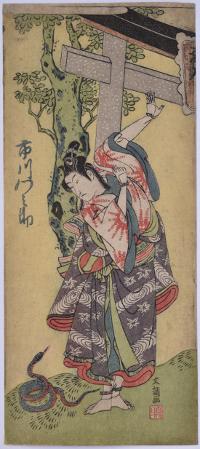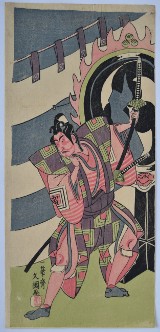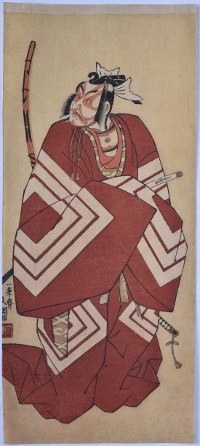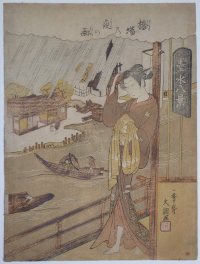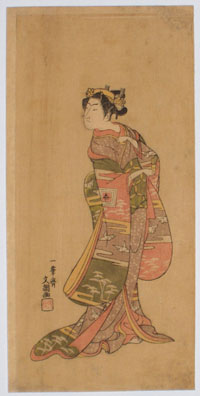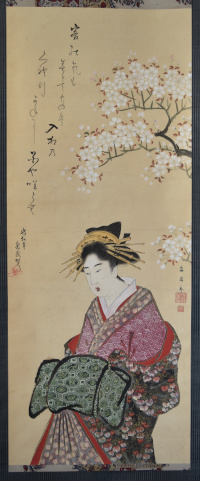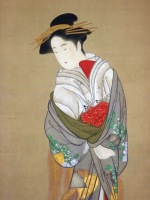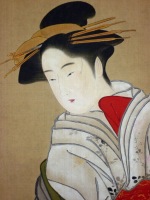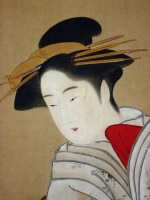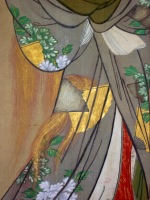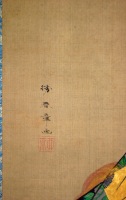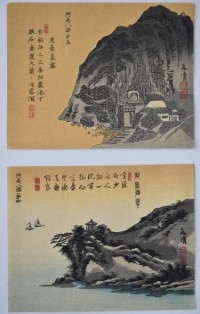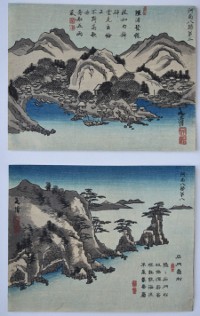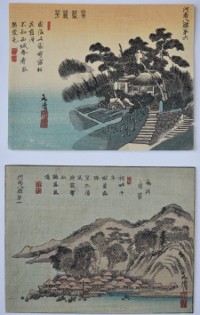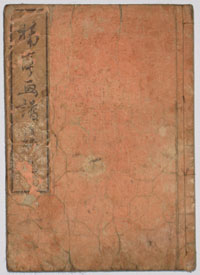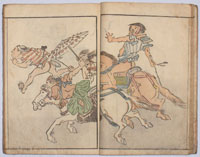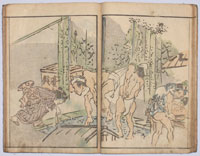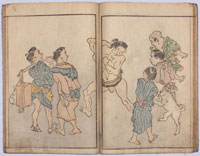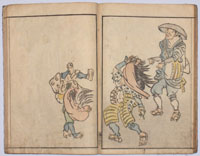Ippitsusai BUNCHO (Fl. c 1755-1790)
Click here to view image full size.
A hosoban showing the actor Ichikawa Monnosuke II standing before a torii and looking down at a snake. Not listed in the Riccar Art Museum Exhibition Of Ukiyo-e By Ippitsusai Buncho, 1978. Published c 1769.
Very good impression. Extremely well preserved colour. Probably slightly trimmed on right and slight soil, otherwise very good condition. Signed Buncho ga.
Status: Sold
Ippitsusai BUNCHO (Fl. c. 1765-1792)
Click here to view image full size.
A hosoban showing the actor Ichikawa Raizo II as Kanesashi Goro Katsuhide in the play Kawaranu hanasakae hachi no ki, “The Ever-Blooming Potted Tree.” Performed at the Nakamura-za Theatre in 11/1769. Extremely rare: Another impression is illustrated in an Exhibition of Ukiyo-e by Ippitsusai Buncho, Riccar Art Museum, 1978, no. 40. Their example is annotated on the top left: Meiwa 6 nen, kaomise, Kanesashi Goro, Ichikawa Raizo. The kaomise production was always in the 11th month and was quite literally the “face showing” of actors for the coming season. There are a considerable number of hosobans annotated in the same hand around this time – obviously by an avid theatre goer. Buncho was the pre-eminent designer of hosobans in the second half of the 18th century. He subsequently became a samurai. He was also a painter and, together with Shunsho, produced the fine three volume book Ehon butai ogi of stage actors in 1770.
Superb impression, colour and condition: As the day it was printed. Signed Ippitsusai Buncho ga with seal Mori uji (offset as on the Riccar impression).
Status: Sold
Ippitsusai BUNCHO (Active c 1755-1790)
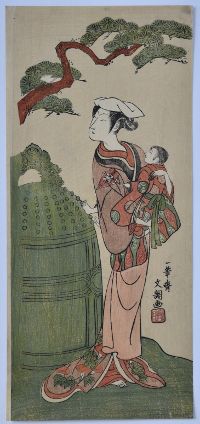
Click here to view image full size.
Little is known of Buncho’s life. With Shunsho, he was the pre-eminent designer of actor hosoban producing them during the short period of 1766-1773. He also collaborated with Shunsho on the fine 3 vol. Ehon butai ogi in 1770. Shows the actor Nakamura Matsue I in an onnagata role holding a child beside a large bell. This is possibly Matsue playing Sakuragi, the wife of Munesada, in the play Kuni no Hana Ono no Itsumoji performed at the Nakamura-za Theatre in 11/1771. Provenance: Ex collection Ernest Le Veel. Sold lot 13, 3rd sale, Ader Picard Tajan, 5/11/1981. Seal au verso. Rare: Not listed in Exhibition Of Ukiyo-e By Ippitsusai Buncho, Riccar Art Museum, 1978.
Fine impression. Very good colour. Fine condition. Signed Ippitsusai Buncho ga with Mori uji seal.
Status: Sold
Ippitsusai BUNCHO (1763-1840)
Click here to view image full size.
Ichikawa Danjuro V probably as Watanabe Kiou Takiguchi in the play Nue no mori ichiyou no matsu performed at the Nakamura-za in the 11th month of 1770. It was in this month that Koshiro III took the name of Danjuro V. Shows Danjuro in the iconic costume of the Shibaraku scene with the giant mon. Buncho was a connoisseur of paintings ( he wrote Buncho gadan [ Treatise on Painting ] ), and was one of the most important painters and print designers of this period. A fine design and extremely rare.
Fine impression. The background probably “turned” from a pale blue ( as usual ). Trimmed into signature at left, otherwise very good condition. Signed Ippitsusai Buncho ga.
Status: Sold
Ippitsusai BUNCHO (1763-1840)
Click here to view image full size.
A chuban print showing a beauty standing on a balcony adjusting a comb in her hair. She gazes at a ferry crossing the Sumida River in rain. One of a series with title on an ink-cake top right: Bokusui hakkei, “Eight Views of Inky Water” ( “Inky Water” being the colloquial term given to the Sumida River ); sub-title: Hashiba no yora no ame, “Evening Rain at Hashiba.” Ex Gonse collection, first sale, no. 13, pl. 2 ( seal au verso ) and Vever collection, Sotheby & Co, Part II, 1975, lot 101 ( seal bottom right ). Extremely rare. A much trimmed impression is in T.N.M., vol. 1, no. 827.
Fine impression. Some “turning” of colours, otherwise very good condition. Signed Ippitsusai Buncho ga with Mori uji seal.
Status: Sold
Ippitsusai BUNCHO ( Fl. c. 1765 – 92 )
Click here to view image full size.
A fine full length hosoban portrait of the actor Ichikawa Benzo I in the role of Kuretake in the play Tenjiku Tokubei kokyo no torigashi performed at the Nakamura-za in the 8th month of 1768. A very damaged example is illustrated in Exhibition of Ukiyo-e by Ippitsusai Buncho, Riccar Art Museum, 1978, no. 23.
Very good impression. Background turned, otherwise very good colour. Slight toning, otherwise very good condition. Signed Ippitsusai Buncho ga.
Status: Sold
KYOJINSAI (Fl. c 1789-1801)
Click here to view image full size.
A large and fine original painting by an artist whom I am unable to find in the literature; possibly a pseudonym. Shows a high-ranking courtesan wearing a sumptuous kimono under cherry blossom. Full colour on paper, 49.25 x 20 in; 125 x 51 cms. The calligraphy above is by Kan’watei Onitake, best known as the author of a series of yomihon entitled Katakiuchi kidan Jiraiya setsuwa , “The Tale of the Gallant Jiraiya,” also known as the Jiraiya monogatari published in 11 volumes from 1806-7. The protagonist was a thief-come-wizard who is usually depicted astride a giant toad. Onitake was a pupil of Tani Buncho, Kyokutei Bakin and Santo Kyoden. It translates as a courtesan musing on the fact that customers’ attention in the spring turns to buying many things and, as the sun sets, will there be many clients in the Yoshiwara gathering as thickly as the cherry blossom. Signed Kan’watei Onitake san with a kakihan of an octopus. On the right the signature and seal of Kyojinsai. On the lid of the box is an inscription reading Kansei-ki Kyojinsai-hitsu oka no tayu sugata gasan, “A Kansai period inscribed painting of a high-class courtesan under cherry blossoms brushed by Kyojinsai.” And a repeat of the Onitake inscription. On the inside of lid: Showa shinyu Yayoi chukan, “Mid-March of the metal rooster [Showa 56/1981].” Appraised by Kimura Suetsuke ((a dealer and Ukiyo-e expert). Very good condition.
Status: Available
Katsukawa SHUNSHO ( 1726-1792 )
Click here to view image full size.
An extremely important painting by one of the most important artists of his day. One of the great ukiyo-e print designers – especially of actor prints. He lived in Edo and first studied under Katsukawa Shunsui and Ko Sukoku. Little is known of his private life. He had many able pupils including Hokusai. The seal he used had Hayashi on the side of a jar ( tsubo ), hence he was called Tsubo. In 1776, together with Kitao Shigemasa, illustrated the famous book Seiro bijin awase sugata kagami. Also the Ehon butai ogi with Buncho in 1770.
This was one of the paintings chosen to be exhibited at the Isetan Department Store to commemorate the Tokyo Olympics in 1964. The exhibit arranged by The Mainichi Newspapers. A committee consisting of Mr. Seiichiro Takahashi, president of the Japan Art Academy, Mr. Issho Tanaka, director of the Tokyo National Cultural Assets Research Institute, Mr. Seiroku Noma, an historian, Mr. Muneshige Narasaki, chairman of the Ukiyoe Association, Mr. Sadao Kikuchi of the Tokyo National Museum, Mr. Teruji Yoshida, an Ukiyoe connoisseur, Mr. Fusui Kaneko, an Ukiyoe connoisseur, Mr. Yasunosuke Ogiwara, an Ukiyoe connoisseur, and other collectors vetted all the paintings and they represented the best that could be put together at the time. Full colour on silk including gold leaf. Exquisitly painted. Slightly creased otherwise in good condition. Double box with inscription in gold. Image size 39 x 12.5 in; 99 x 31.75 cms. Painted c 1781-9.
Signed Katsu Shunsho ga with seal. Ex collection Oda Eisaku, a famous art dealer and collector.
Status: Sold
Katsukawa SHUNSHO (1726?-1792)

Click here to view image full size.
An original painting, sumi and full colour on silk, 32.25 x 10 in; 82 x 25.5 cms. An important print artist and his paintings being considered one of the glories of Ukiyo-e. Produced a considerable number of hosoban actor prints from the late 1760s on as well as collaborating on the Ehon butai ogi illustrated book with Buncho in 1770 and Seiro bijin awase sugata kagami with Kitao Shigemasa in 1776. He had many pupils including Shunko, Shun’ei and Hokusai. Shows a court beauty reclining and reading a book. The painting of the face, hair and the lacquer stand holding the cloth screen are exceptional. Painted c. 1789. In very good condition.
Signed Katsu Shunsho ga with seal Jui.
Status: Sold
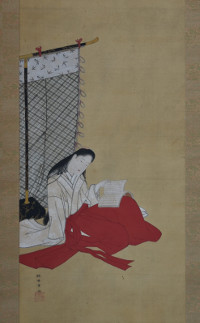
Click here to view image full size.
BUNSEI (Active c. 1830 -1844)
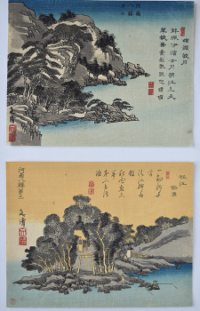
Click here to view image full size.
A complete set of Eight Views of Xiaoxiang, modern Hunan Province, China. These eight views were taken up by Japanese artists such as Hiroshige and transposed to Japan becoming sets like the Eight Views of Omi, etc. Bunsei was a pupil of Tani Buncho. He seems to have made a speciality of this subject and there is a slightly larger version set of the same subject. Published c. 1830s. Provenance: Ex Hayashi with his seal on most of the designs. Rare complete.
Very good impressions and colour. Minor edge wormage, othwerwise very good condition. Each signed Bunsei.
Status: Sold
Nishimura NANTEI (1775-1834)
Click here to view image full size.
One volume complete Nantei gafu kohen, “A Book of Drawings by Nantei, Second Part.” Also published as Jimbutsu gafu. Published by Bunchodo ( Yoshida Shimbei ), Bunsei 9 ( 1826 ), the preface dated Bunsei 6 ( 1823 ). Fine designs of everyday life in the Kyoto area.
Original light orange covers and brown title slip. Some wear to covers. Slight thumbing to lower corners, otherwise a nice copy.
Status: Sold
Artists
( A to Z )
Kyogado ASHIKUNI ( Fl. c. 1807 – 1818 )
Gigado ASHIYUKI ( Fl. c. 1814 – 1833 )
Ki BAITEI ( 1734 – 1810 )
Takizawa BAKIN ( 1767 – 1848 )
Ono BAKUFU ( 1888 – 1976 )
Georges BIGOT ( 1860 – 1927 )
Kawamura BUMPO ( 1779 – 1821 )
Ippitsusai BUNCHO ( Fl. c. 1765 – 1792 )
Toyohara CHIKANOBU ( 1838 – 1912 )
Kishi CHIKUDO ( 1826 – 1897 )
Tsubaki CHINZAN ( 1801 – 1854 )
Eishosai CHOKI ( Fl. c. 1756 – 1808 ). See also SHIKO
Rekisentei EIRI ( Fl. c. 1790 – 1800 )
Keisai EISEN ( 1790 – 1848 )
Hosoda EISHI ( 1756 – 1829 )
Hosoda EISHO ( Fl. c. 1780 – 1800 )
Ichirakutei EISUI ( Fl. c. 1790 – 1823 )
Kikugawa EIZAN ( 1787 – 1867 )
Hirano HAKUHO ( 1879 – 1957 )
Elizabeth KEITH ( 1887 – 1956 )
Imao KEINEN ( 1845 – 1924 )
Yashima GAKUTEI ( 1786 – 1868 )
Ogata GEKKO ( 1859 – 1920 )
Adachi GINKO ( Fl. c. 1847 – 1897 )
Matsumura GOSHUN ( 1752 – 1811 )
GYOSAI. See Kawanabe KYOSAI
Hirano HAKUHO ( 1879 – 1957 )
Suzuki HARUNOBU ( 1724 – 1770 )
Kawase HASUI ( 1883 – 1957 )
Kitagawa HIDEMARO ( Fl. c. early 19th century )
Kinoshita HIRONOBU ( Fl. c. 1851 – 1870 )
Gosotei HIROSADA ( Fl. c. 1847 – 1863 )
Ichiryusai HIROSHIGE ( 1797 – 1858 )
Ichiryusai HIROSHIGE II ( 1826 – 1869 )
Ando HIROSHIGE III ( 1843 – 1894 )
Nakamura HOCHU ( Fl. c. late 18th to early 19th century )
Sakai HOITSU ( 1761 – 1828 )
Totoya HOKKEI ( 1780 – 1850 )
Teisai HOKUBA ( 1771 – 1844 )
Shunkosai HOKUEI (Active 1824-1837)
Katsushika HOKUGA ( Fl. c. 1830 )
Shotei HOKUJU ( Fl. c. 1789 – 1818 )
Katsushika HOKUSAI ( 1760 – 1849 ). Also used numerous other names such as: SORI, SHUNRO, SHINSAI
Shokosai HOKUSHU ( Fl. c. 1808 – 1832 )
KEISAI. See Kitao MASAYOSHI
Suzuki KIITSU ( 1796 – 1858 )
Kitagawa KIKUMARO ( Fl. c. ? – 1830 ). See TSUKIMARO
Kobayashi KIYOCHIKA ( 1847 – 1915 )
Torii KIYOHIRO ( Fl. c. 1737 – 1771 )
Torii KIYOMASA ( Fl. c. 1700 – 1722 )
KIYOMINE. See Torii KIYOMITSU II
Torii KIYOMITSU ( 1735 – 1785 )
Torii KIYOMITSU II ( 1787 – 1868 ). See KIYOMINE
Torii KIYONAGA ( 1752 – 1815 )
Torii KIYONOBU ( 1664 – 1729 )
Torii KIYONOBU II ( 1706 – 1763 )
Torii KIYOTSUNE ( Fl. c. 1757 – 1779 )
Isoda KORYUSAI ( Fl. c. 1767 – 1788 )
Ohara KOSON ( 1877 – 1945 ). See SHOSON
Torii KOTONDO ( 1900 – 1976 )
Toyohara KUNICHIKA ( 1835 – 1900 )
Utagawa KUNIHIRO ( Fl. c. 1815 – 1843 )
Ichiunsai KUNIHISA ( 1832 – 1891 )
Utagawa KUNINAO ( 1793 – 1854 )
Utagawa KUNISADA ( 1786 – 1865 )
Utagawa KUNISADA II ( 1823 – 1880 )
Utagawa KUNISATO ( ? – 1858 )
Utagawa KUNITERU ( 1808 – 1876 )
KUNITERU. See Utagawa SADASHIGE
Utagawa KUNITERU II ( 1829 – 1874 )
Utagawa KUNIYASU ( 1794 – 1832 )
Ichiyusai KUNIYOSHI ( 1797 – 1861 )
Santo KYODEN. See Kitao MASANOBU
Kawanabe KYOSAI ( 1831 – 1889 ). See GYOSAI
Okumura MASANOBU ( 1686 – 1764 )
KitaoMASANOBU ( 1761 – 1816 ). See Santo KYODEN
Kitao MASAYOSHI ( 1764 – 1824 ). See KEISAI
Oishi MATORA ( 1794 – 1833 )
Hishikawa MORONOBU ( Fl. c. 1618 – 1694 )
Nishimura NANTEI ( 1775 – 1834 )
Utagawa NOBUKATSU ( Fl. c. 1830 – 1844 )
Watanabe NOBUKAZU ( Fl. c. late 19th century )
Hishikawa RYUKOKU ( Fl. c. 1808 – 1816 )
Jokei RYUKOSAI ( Fl. 1772 – 1816 )
Gokitei SADAFUSA ( Fl. c. 1825 – 1850 )
Hasegawa SADAHARU ( Fl. c. 1830 – 1844 )
Gokotei SADAKAGE ( Fl. c. 1818 – 1844 )
Utagawa SADAHIDE ( 1807 – 1873 )
Hasegawa SADANOBU ( 1809 – 1879 )
Utagawa SADASHIGE ( Fl. c. mid 19th century ). See KUNITERU
Gofutei SADATORA ( Fl. c. 1825 )
Yamaguchi SHIGEHARU ( 1803 – 1853 )
Kitao SHIGEMASA ( 1739 – 1820 )
Nishimura SHIGENAGA ( 1697 ? – 1756 )
Nishimura SHIGENOBU ( Fl. c. 1724 – 1735 )
SHIKO. See Eishosai CHOKI
Ryuryukyo SHINSAI ( 1764 – 1820 )
Ito SHINSUI ( 1898 – 1972 )
Kojima SHOGETSU ( Fl. c. 1880 – 1890 )
SHOSON. See Ohara KOSON
Takahashi SHOTEI ( 1871 – 1945 )
Yamamoto SHOUN ( 1870 – 1965 )
Yamakawa SHUHO ( 1898 – 1944 )
Katsukawa SHUNCHO ( Fl. c. 1780 – 1795 )
Takehara SHUNCHOSAI ( Fl. c. 1772 – 1801 )
Katsukawa SHUN’EI ( 1762 – 1819 )
Katsukawa SHUNKO ( 1743 – 1812 )
Hishikawa SHUNKYO ( Fl. c. early 19th century )
Kubo SHUNMAN ( 1757 – 1820 )
Katsukawa SHUNSEN ( Fl. c. 1762 – 1830 )
Natori SHUNSEN ( 1886 – 1960 )
Gatoken SHUNSHI ( Fl. c. 1820 – 1828 )
Katsukawa SHUNSHO ( 1726 – 1792 )
Katsukawa SHUNTEI ( 1770 – 1820 )
Katsukawa SHUNZAN ( Fl. c. 1782 – 1798 )
Yamaguchi SOKEN ( 1759 – 1834 )
Ikeno TAIGA ( 1723 – 1776 )
Katsukawa TERUSHIGE ( Fl. c. 1715 – 1725 )
Mori TETSUZAN (1775-1841)
Migita TOSHIHIDE ( 1863 – 1925 )
Mizuno TOSHIKATA ( 1866 – 1908 )
Okumura TOSHINOBU ( Fl. c. 1717 – 1750 )
Utagawa TOYOHARU ( 1735 – 1814 )
Utagawa TOYOHIRO ( 1773 – 1828 )
Utagawa TOYOKUNI ( 1769 – 1825 )
Utagawa TOYOKUNI II ( 1777 – 1835 ). See TOYOSHIGE
Yamamura TOYONARI ( 1885 – 1942 )
Ishikawa TOYONOBU ( 1711 – 1785 )
TOYOSHIGE. See Utagawa TOYOKUNI II
TSUKIMARO. See Kitagawa KIKUMARO
Kitano TSUNETOMI ( 1880 – 1947 )
Toyokawa UMEKUNI ( Fl. c. 1816 – 1826 )
Kitagawa UTAMARO ( 1753 – 1806 )
Kitagawa UTAMARO II ( ? – 1831 )
Inoue YASUJI ( 1864 – 1889 )
Hiroshi YOSHIDA ( 1876 – 1950 )
Ipposai YOSHIFUJI ( 1828 – 1887 )
Utagawa YOSHIIKU ( 1833 – 1904 )
Utagawa YOSHIKATA ( Fl. c. 1841 – 1864 )
Utagawa YOSHIKAZU ( Fl. c. 1850 – 1870 )
Toyokawa YOSHIKUNI ( Fl. c. 1803 – 1840 )
Utagawa YOSHIMUNE ( 1817 – 1880 )
Ichiyosai YOSHITAKI ( 1841 – 1899 )
Utagawa YOSHITORA ( Fl. c. 1850 – 1880 )
Taiso YOSHITOSHI ( 1839 – 1892 )
Utagawa YOSHITSURU ( Fl. c. 1840 – 1850 )
Ichieisai YOSHITSUYA ( 1822 – 1866 )
Mori YOSHIYUKI ( 1835 – 1879 )
Shibata ZESHIN ( 1807 – 1891 )
